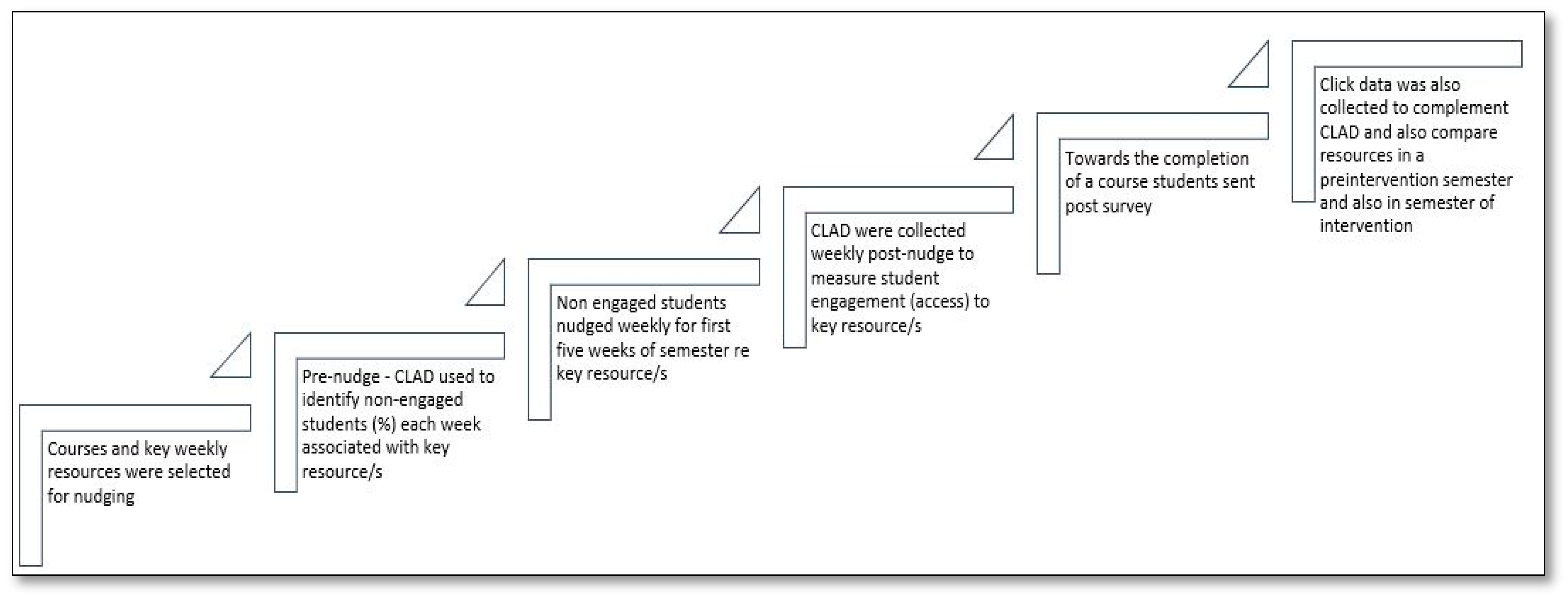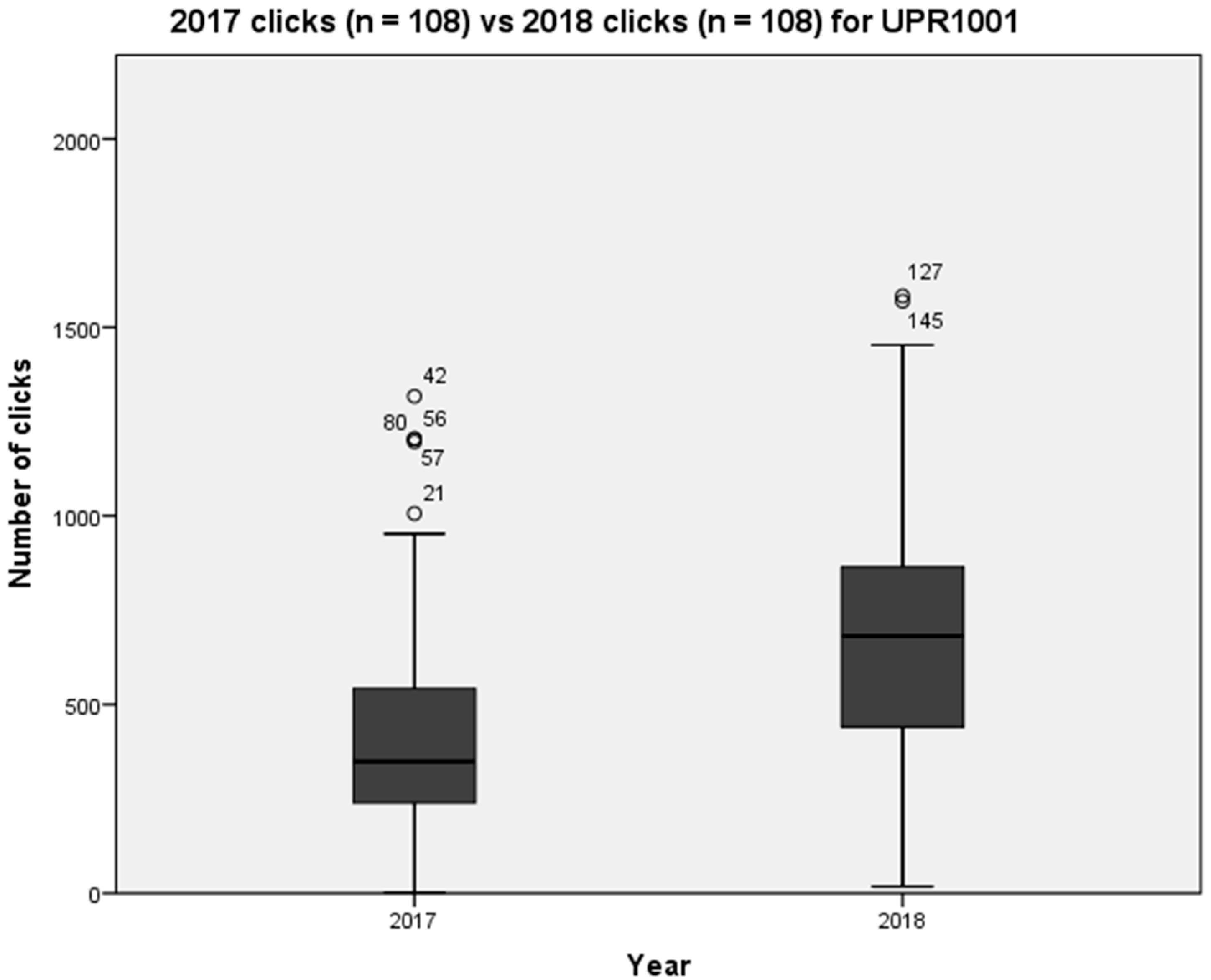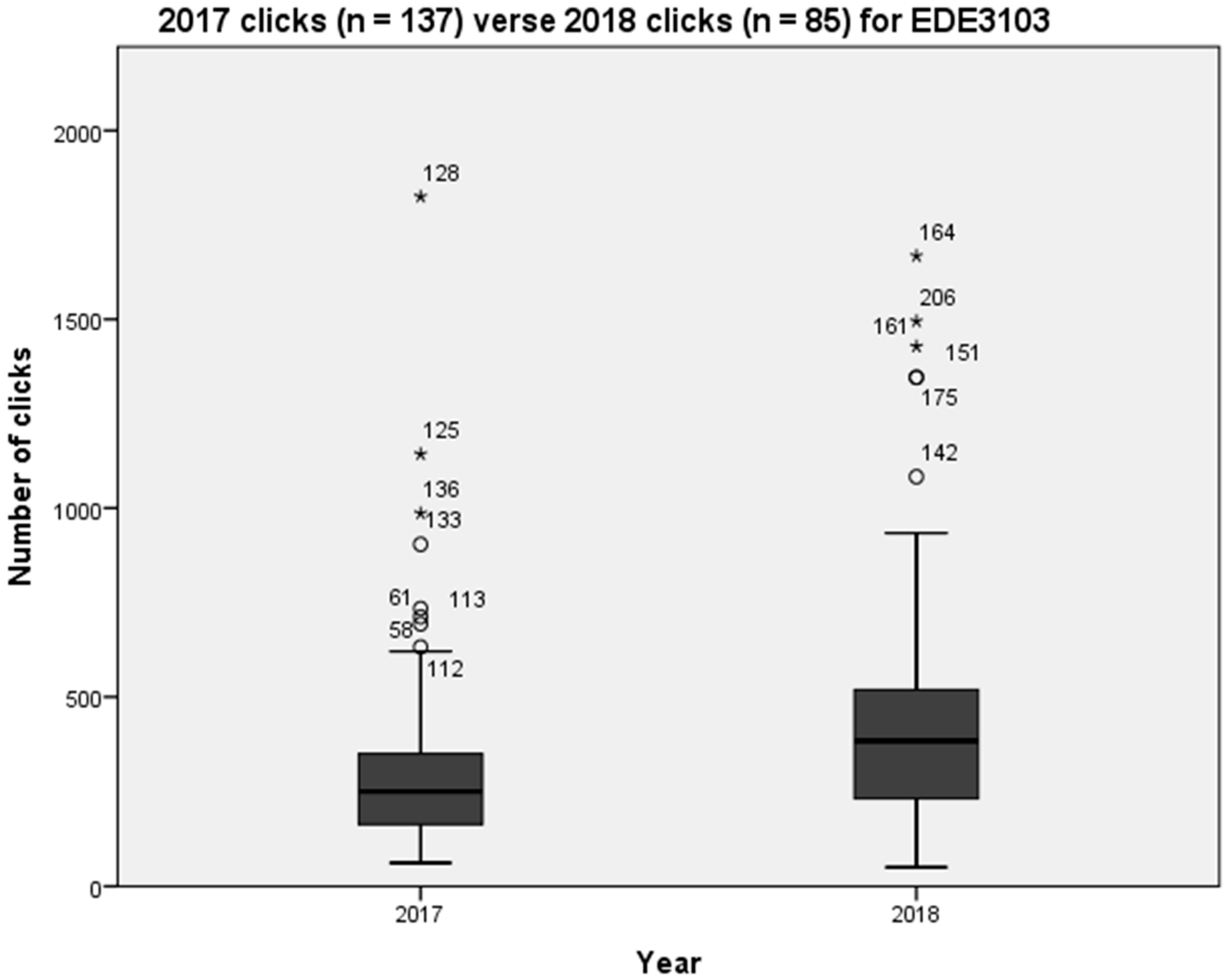Empirical Evidence to Support a Nudge Intervention for Increasing Online Engagement in Higher Education
Abstract
1. Introduction
2. Literature Review
2.1. Monitoring Student Engagement with Online Course Materials Using Learning Analytics Data
2.2. Nudging, a CLAD-Based Intervention
3. Materials and Methods
Details on the Nudge Intervention
The [teaching team] team notice that at the end of Week 2 you have as yet not accessed the Assignment guidelines and support materials. Please familiarize yourself with the assessment expectations for this course as soon as possible. There is also now a recorded presentation to compliment Assignment 1 that can be found via the Useful Links Tab at the top of the study desk. Know that the team are here to support you and wish you all the best for your learning journey.
It is important to allocate time this week to listen to the course introduction and virtual study desk tour (presentation). 70% of students have now completed this task and have confirmed the value of this presentation.
4. Results and Discussion
4.1. Impact of the Nudge Intervention
4.2. Student Perceptions of the Nudge Intervention
Made you feel like the support was there for online students. [Education course]It did prompt me when I knew I had been a little slack as well as shows that someone does care and just not a number. [Education course][U]seful for reminding students who are busy on what they need to catch up on. [Planning course]
I found there was too much information and a lot of emails, I didn’t need all the information. [Education course]To be honest, some of the tone was very negative and quite big brotherish. Other lecturers would at least start with a positive message. I would read the message and get stressed out. [Education course]
Studying online via distance education can sometimes make it difficult to stay up to date, the sharing of % of students’ engagement was a great motivation to catch up to where I needed to be. [Education course]Can help to know if you are or aren’t the only one struggling with workload. [Planning course]I understand what is required of me to successfully complete a subject. What others have or haven’t done has no bearing on my study regime. [Planning course]I became quite stressed after this communication. I felt I did not have enough time to engage in everything offered in this course. [Education course]
5. Limitations, Implications, and Future Research
6. Conclusions
Author Contributions
Funding
Institutional Review Board Statement
Informed Consent Statement
Data Availability Statement
Acknowledgments
Conflicts of Interest
References
- Kahu, E.R.; Picton, C.; Nelson, K. Pathways to engagement: A longitudinal study of the first-year student experience in the educational interface. High. Educ. 2020, 79, 657–673. [Google Scholar] [CrossRef]
- Tight, M. Student retention and engagement in higher education. J. Furth. High. Educ. 2020, 44, 689–704. [Google Scholar] [CrossRef]
- Farrell, O.; Brunton, J. A balancing act: A window into online student engagement experiences. Int. J. Educ. Technol. High. Educ. 2020, 17, 1–19. [Google Scholar] [CrossRef]
- Brown, A.; Lawrence, J.; Basson, M.; Axelsen, M.; Redmond, P.; Turner, J.; Maloney, S.; Galligan, L. The creation of a nudging protocol to support online student engagement in higher education. Active Learn. High. Educ. 2022, 14697874211039077. [Google Scholar] [CrossRef]
- Bergdahl, N. Engagement and disengagement in online learning. Comput. Educ. 2022, 188, 104561. [Google Scholar] [CrossRef]
- Brown, M.; Hughes, H.; Keppell, M.; Hard, N.; Smith, L. Stories from students in their first semester of distance learning. Int. Rev. Res. Open Distance Learn. 2015, 16, 1–17. [Google Scholar] [CrossRef]
- O’Shea, S.; Stone, C.; Delahunty, J. “I ‘feel’ like I am at university even though I am online.” Exploring how students narrate their engagement with higher education institutions in an online learning environment. Distance Educ. 2015, 36, 41–58. [Google Scholar] [CrossRef]
- Herrington, J.; Reeves, T.C.; Oliver, R. Authentic learning environments. In Handbook of Research on Educational Communications and Technology; Spector, J., Merrill, M., Elen, J., Bishop, M., Eds.; Springer: New York, NY, USA, 2014; pp. 401–412. [Google Scholar]
- Stone, C.; Springer, M. Interactivity, connectedness and’teacher-presence’: Engaging and retaining students online. Aust. J. Adult Learn. 2019, 59, 146–169. [Google Scholar]
- Burton, L.J.; Summers, J.; Lawrence, J.; Noble, K.; Gibbings, P. Digital literacy in higher education: The rhetoric and the reality. In Myths in Education, Learning and Teaching: Policies, Practices and Principles; Harmes, M.K., Huijser, H., Danaher, P.A., Eds.; Palgrave Macmillan: Hampshire, UK; New York, NY, USA, 2015; pp. 151–172. [Google Scholar]
- Moore, K.; Bartkovich, J.; Fetzner, M.; Ison, S. Success in cyberspace: Student retention in online courses. J. Appl. Res. Community Coll. 2003, 10, 107–118. [Google Scholar]
- Wanner, T. Parallel universes: Student and teacher expectations and interactions in online vs face-to-face teaching and learning environments. Ergo 2014, 3, 37–45. [Google Scholar]
- Willging, P.A.; Johnson, S.D. Factors that influence students’ decision to dropout of online courses. J. Asynchronous Learn. Netw. 2009, 13, 115–127. [Google Scholar]
- Tinto, V. Dropout from higher education: A theoretical synthesis of recent research. Rev. Educ. Res. 1975, 45, 89–125. [Google Scholar] [CrossRef]
- Kuh, G.D. What we’re learning about student engagement from NSSE: Benchmarks for effective educational practices. Change Mag. High. Educ. 2003, 35, 24–32. [Google Scholar] [CrossRef]
- Brown, A.; Redmond, P.; Basson, M.; Lawrence, J. To ‘nudge’ or to ‘nag’: A communication approach for ‘nudging’ online engagement in higher education. In Proceedings of the 8th Annual International Conference on Education and e-Learning, Singapore, 24–25 September 2018. [Google Scholar]
- Guo, P.J.; Kim, J.; Rubin, R. How video production affects student engagement: An empirical study of MOOC videos. In Proceedings of the 1st ACM Learning@ Scale Conference, Atlanta, GA, USA, 4–5 March 2014; ACM: Atlanta, GA, USA, 2014; pp. 41–50. [Google Scholar]
- Higher Education Standards Panel, Improving Retention, Completion and Success in Higher Education: Higher Education Standards Panel Discussion Paper, June 2017; Australian Government, Department of Education and Training: Canberra, Australia, 2017. Available online: https://docs.education.gov.au/system/files/doc/other/final_discussion_paper.pdf (accessed on 20 January 2023).
- Henrie, C.R.; Halverson, L.R.; Graham, C.R. Measuring student engagement in technology-mediated learning: A review. Comput. Educ. 2015, 90, 36–53. [Google Scholar] [CrossRef]
- Hooda, M.; Rana, C. Learning analytics lens: Improving quality of higher education. Int. J. Emerg. Trends Eng. Res. 2020, 8, 1626–1646. [Google Scholar] [CrossRef]
- Colvin, C.; Rodgers, T.; Wade, A.; Dawson, S.; Gasevic, D.; Buckingham Shum, S.; Nelson, K.J.; Alexander, S.; Lockyer, L.; Kennedy, G.; et al. Student Retention and Learning Analytics: A Snapshot of Australian Practices and a Framework for Advancement; Australian Government Office for Learning and Teaching: Canberra, Australia, 2015. [Google Scholar]
- Newlands, D.A.; Coldwell, J.M. Managing student expectations online. In Advance in Web-Based Learning—ICWL 2005, 4th International Conference. Hong Kong August 2005; Lau, R., Li, Q., Chueng, R., Liu, W., Eds.; Springer: Berlin/Heidelberg, Germany, 2005; pp. 355–363. [Google Scholar]
- Fritz, J.; Whitmer, J. Moving the heart and head: Implications for learning analytics research. EDUCAUSE Rev. [Online]. 2017. Available online: https://er.educause.edu/articles/2017/7/moving-the-heart-and-head-implications-for-learning-analytics-research (accessed on 20 January 2023).
- Wong, B.T.M. Learning analytics in higher education: An analysis of case studies. Asian Assoc. Open Univ. J. 2017, 12, 21–40. [Google Scholar] [CrossRef]
- Pardo, A.; Jovanovic, J.; Dawson, S.; Gasevic, D.; Mirriahi, N. Using learning analytics to scale the provision of personalised feedback. Br. J. Educ. Technol. 2017, 50, 128–138. [Google Scholar] [CrossRef]
- Thaler, R.H.; Sunstein, C.R. Nudge: Improving Decisions about Health, Wealth, and Happiness; Penguin: New York, NY, USA, 2008. [Google Scholar]
- Selinger, E.; Whyte, K. Is there a right way to nudge? The practice and ethics of choice architecture. Sociol. Compass 2011, 5, 923–935. [Google Scholar] [CrossRef]
- Damgaard, M.T.; Nielsen, H.S. Nudging in Education (IZA Discussion Paper No. 11454); IZA Institue of Labor Economics: Bonn, Germany, 2018. [Google Scholar]
- Azmat, G.; Bagues, M.; Cabrales, A.; Iriberri, N. What you don’t know... Can’t hurt you? A field experiment on relative performance feedback in higher education. In IZA Discussion Paper Series; IZA: Bonn, Germany, 2016. [Google Scholar]
- Davis, D.; Chen, G.; Hauff, C.; Houben, G.; Jivert, I.; Kizilcec, R. Follow the successful crowd: Raising MOOC completion rates through social comparison at scale. In Proceedings of the Seventh International Learning Analytics & Knowledge Conference, Vancouver, BC, Canada, 13–17 March 2017; pp. 454–463. [Google Scholar]
- Kizilcec, R.F.; Schneider, E.; Cohen, G.L.; McFarland, D.A. Encouraging forum participation in online courses with collectivist, individualist and neutral motivational framings. elearning Pap. 2014, 37, 12–22. [Google Scholar]
- Rogers, T.; Feller, A. Discouraged by peer excellence: Exposure to exemplary peer performance causes quitting. Psychol. Sci. 2016, 27, 365–374. [Google Scholar] [CrossRef] [PubMed]
- Patterson, R.W. Can behavioral tools improve online student outcomes? Experimental evidence from a massive open online course. J. Econ. Behav. Organ. 2018, 153, 293–321. [Google Scholar] [CrossRef]
- Pistolesi, N. Advising students on their field of study: Evidence from a French University reform. Labour Econ. 2017, 44, 106–121. [Google Scholar] [CrossRef]
- Broda, M.; Yun, J.; Schneider, B.; Yeager, D.S.; Walton, G.M.; Diemer, M. Reducing Inequality in academic success for incoming college students: A randomized trial of growth mindset and belonging interventions. J. Res. Educ. Eff. 2018, 11, 317–338. [Google Scholar] [CrossRef]
- Sclater, N.; Peasgood, A.; Mullan, J. Learning Analytics in Higher Education: A Review of UK and International Practice; Jisc.: Bristol, UK, 2016. [Google Scholar]
- Tashakkori, A.; Teddlie, C. Quality of inferences in mixed methods research: Calling for an integrative framework. In Advances in Mixed Methods Research; Bergman, M., Ed.; SAGE: Thousand Oaks, CA, USA, 2008; Volume 53, pp. 101–119. [Google Scholar]
- Bullock, S.; Christou, T. Exploring the radical middle between theory and practice: A collaborative self-study of beginning teacher educators. J. Teach. Educ. 2009, 5, 75–88. [Google Scholar] [CrossRef]
- Van der Meer, J.; Scott, S.; Pratt, K. First semester academic performance: The importance of early indicators of non-engagement. Stud. Success 2018, 9, 1–13. [Google Scholar] [CrossRef]
- Blumenstein, M.; Liu, D.Y.T.; Richards, D.; Leichtweis, S.; Stephens, J.M. Data-informed nudges for student engagement and success. In Learning Analytics in the Classroom: Translating Learning Analytics Research for Teachers; Lodge, J.M., Horvath, J.C., Corrin, L., Eds.; Routledge: Oxon, UK; New York, NY, USA, 2019; pp. 185–207. [Google Scholar]
- Redmond, P.; Heffernan, A.; Abawi, L.; Brown, A.; Henderson, R. An online engagement framework for higher education. Online Learn. 2018, 22, 183–204. [Google Scholar] [CrossRef]
- Pistilli, M.D.; Arnold, K.E. In practice: Purdue signals: Mining real-time academic data to enhance student success. About Campus 2010, 15, 1–32. [Google Scholar] [CrossRef]



Disclaimer/Publisher’s Note: The statements, opinions and data contained in all publications are solely those of the individual author(s) and contributor(s) and not of MDPI and/or the editor(s). MDPI and/or the editor(s) disclaim responsibility for any injury to people or property resulting from any ideas, methods, instructions or products referred to in the content. |
© 2023 by the authors. Licensee MDPI, Basel, Switzerland. This article is an open access article distributed under the terms and conditions of the Creative Commons Attribution (CC BY) license (https://creativecommons.org/licenses/by/4.0/).
Share and Cite
Brown, A.; Basson, M.; Axelsen, M.; Redmond, P.; Lawrence, J. Empirical Evidence to Support a Nudge Intervention for Increasing Online Engagement in Higher Education. Educ. Sci. 2023, 13, 145. https://doi.org/10.3390/educsci13020145
Brown A, Basson M, Axelsen M, Redmond P, Lawrence J. Empirical Evidence to Support a Nudge Intervention for Increasing Online Engagement in Higher Education. Education Sciences. 2023; 13(2):145. https://doi.org/10.3390/educsci13020145
Chicago/Turabian StyleBrown, Alice, Marita Basson, Megan Axelsen, Petrea Redmond, and Jill Lawrence. 2023. "Empirical Evidence to Support a Nudge Intervention for Increasing Online Engagement in Higher Education" Education Sciences 13, no. 2: 145. https://doi.org/10.3390/educsci13020145
APA StyleBrown, A., Basson, M., Axelsen, M., Redmond, P., & Lawrence, J. (2023). Empirical Evidence to Support a Nudge Intervention for Increasing Online Engagement in Higher Education. Education Sciences, 13(2), 145. https://doi.org/10.3390/educsci13020145





